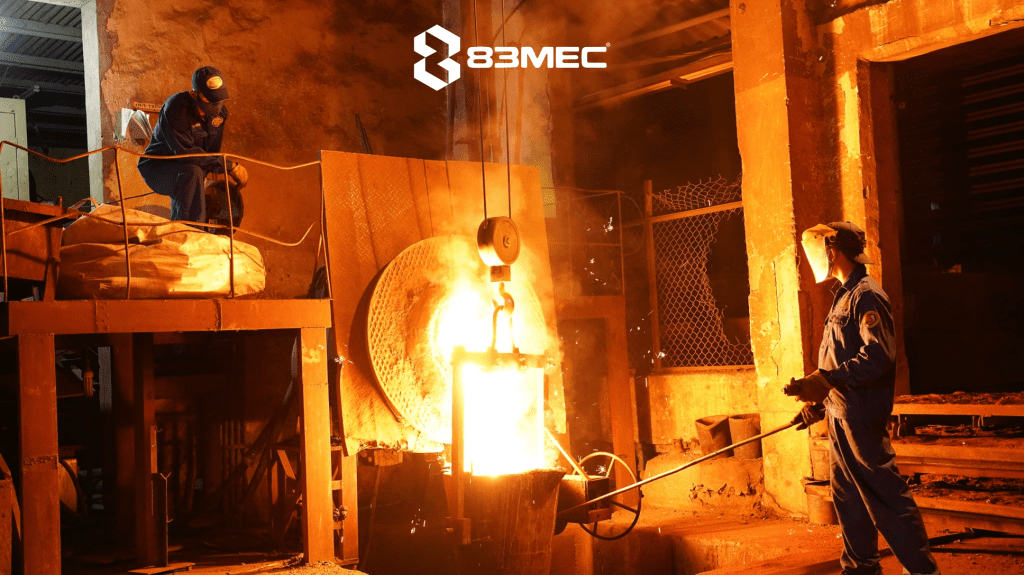To soften or harden the material, heat treatment entails heating or cooling to a significant degree or heat treatment for a specified period of time. Heat treatment necessitates a precise and regulated procedure for the duration and rate of heat exchange with the material. Numerous developed nations have not yet disclosed and continue to conceal heat treatment technology – the element that produces low-cost, high-utility materials.
1. What is the heat treatment method?
Heat treatment is the process of applying heat to materials to create metal products and components with the desired mechanical properties and with only three main factors: temperature factor, time factor, heat retention factor, and material cooling factor. With these three factors, the sequential process, and various indicators, different times will produce efficient materials with distinct properties. By heating a metal or alloy to a predetermined temperature range, heat treatment is accomplished. Maintain this temperature level for some time after that (the length of time to maintain the temperature depends on the mechanical properties of the material). The final step is to cool the material. Therefore, the microstructure or chemical composition of the starting material is altered to create a material with the desired properties. To further modify the properties of metals and alloys, the simultaneous effects of plastic deformation and heat treatment or chemical and thermal products are combined.
2. A global overview of heat treatment
Countries such as the United States, the United Kingdom, China, and Russia are committed to enhancing their role and position, expanding their influence in the region, and developing their arms manufacturing industry. In addition to being used as raw materials daily, metal is also widely employed in military applications.
Countries around the world use a variety of processes, but all have the same objective: to produce a material with the desired properties.
3. Several primary heat treatment techniques at 83MEC
3.1 Fundamental thermal processes at 83MEC
The equipment at the 83MEC factory is considered to be comprehensive, as it meets a variety of customers’ heat treatment requirements. Here are some of the heat treatment techniques used at the facility:
In the annealing process, the materials are heated to a specific temperature. After maintaining the temperature, the workpiece will cool at a rate of fewer than 200 degrees per hour. This technique reduces the material’s hardness and increases its ductility, making it useful for cutting, pressure processing, casting, welding, and balancing steel.
Normalizing method: This is a method of heat treatment for materials in which the material is thoroughly heated, and then the temperature is maintained for a period of time. The substance was then cooled in (static) air. The normalization process is similar to annealing, but the resulting product is faster and less expensive. Normalizing will be preferred when both annealing and normalizing satisfy the mechanical property specifications.
This method of hardening requires heating the material above a critical temperature threshold. The heat retention will be maintained for a period of time by cooling at a rate that exceeds the critical cooling rate. We will obtain a martensite structure with high hardness but low ductility and toughness after cooling. Consequently, I always accompany my brother Ram to his heat therapy sessions.
In this method of tempering steel, the steel is heated to the appropriate temperature and maintained at that temperature for a period of time to redistribute the metal’s internal structure uniformly. even. After cooling to room temperature, we obtain a product with the required flexibility and toughness in addition to the desired hardness and strength.
3.2 Combined heat treatment techniques at plant 83MEC
Chemical heat treatment: This method modifies the chemical composition of the surface of the material by heating the material and penetrating one or more elements into the steel surface to alter the chemical composition of the layer, resulting in changes in properties that make the treated material superior to the starting material.
Thermomechanical treatment: Unlike chemical heat treatment, this method plasticizes the material through heating by temperature and external forces, thereby altering the material’s structure, mechanical properties, and structure with greater surface area and strength than standard heat treatment.
In conclusion, heat treatment, also known as heat treatment, plays a crucial role in the field of mechanical engineering, as this process imparts superior properties to metals, thereby facilitating their fabrication. Numerous details serve various areas. In addition, it improves the technological properties of materials, which determines the quality of mechanical goods.




